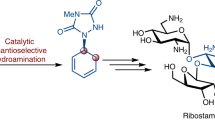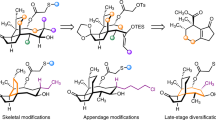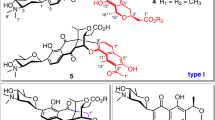Abstract
Synthesis of a cis-decalin moiety, containing an oxa-bridged cis-decalin ring system (11-oxatricyclo(5.3.1.1,703,8)undecane), as a key intermediate of the total synthesis of luminamicin (1) was accomplished. One of the essential steps in our synthetic route is construction of a cis-decaline framework using a one-pot Michael addition-aldol reaction. Additionally, the bridged ether moiety was obtained by an intramolecular 1,6-oxa-Michael reaction of a conjugated aldehyde.
Similar content being viewed by others
Introduction
Pseudomembranous colitis, caused by overgrowth of Clostridium difficile, is often related to recent antibiotic consumption. The condition is increasing and regarded as a serious problem around the world.1, 2 There are few antibacterial drugs (vancomycin, metronidazole, and so on) effective against anaerobic bacteria and there is a growing concern about the emergence and spread of drug-resistant bacteria and ineffective treatment. We have focused on the screening of compounds to combat anaerobic bacteria from microbial metabolites, and a natural product luminamicin (1) was found from the fermentation broth of Streptomyces sp. OMR-59 in 1985.3 Notably, 1 shows selective activity against Clostridium sp., with a minimum inhibitory concentration (MIC) value of 1.0 μg ml−1. Two years after its discovery, McAlpin and co-workers isolated coloradocin, and recognized it was the same compound as 1 based on spectral data analysis.4, 5 Additionally, they determined the relative structure of 1 (Figure 1). It possesses several interesting structural features, including a multi-functional oxa-bridged cis-decalin ring system, with a 10-membered and a 14-membered macrolactone with an enol ether conjugated with a maleic anhydride moiety. However, it proved inactive against most aerobic bacteria. In contrast, two structurally related natural products, nodusmicin6 and nargenicin,7 do exhibit antibacterial activity against some anaerobic bacteria.8
We were therefore interested in studying the key structure moieties responsible for the specific anti-anaerobic bacteria activity. Thus, we determined the absolute stereostructure of 1 using conformational analysis via high-temperature dynamics, NMR spectroscopy, and the modified Mosher method,9 and devised a route to synthesize the compound with an expectation of discovering lead compounds for the development of novel drugs to overcome anaerobic bacteria.
We have previously reported synthesis of the 14-membered macrolactone framework containing conjugated maleic anhydride as one of the characteristic structures in 1.10 The next synthetic challenge for the total synthesis of 1 was construction of the oxa-bridged cis-decalin system. Kallmerten’s group described the total synthesis of (+)-deoxynargenicin11 and Mulzer’s group reported the total synthesis of branimycin.12, 13, 14 Both natural products are structurally similar to 1. In their reports, the racemic cis-decaline moiety of branimycin was synthesized by an intramolecular Diels–Alder reaction, and the bridged ether moiety was constructed using regioselective opening of epoxide by alkoxide, which has a different oxa-bridge system from that of 1. We have previously developed an efficient route for synthesizing 11-oxatricyclo[5.3.1.1,703,8)undecane,15 but further elaboration was difficult at the C-4, 10 and 11 positions. Therefore, a new construction method of oxa-bridged cis-decalin is needed to complete the total synthesis of 1, and herein we report a stereo-controlled synthetic route to generate the oxa-bridged cis-decalin ring unit (2).
Results and Discussion
Our synthetic approach is shown in Scheme 1. The highly-strained tricyclic compound 2 would be obtained by stereoselective protonation of conjugated silyl enol ether (3). Oxa-bridged moiety of 3 would be constructed via an intramolecular 1,6-oxa-Michael reaction of the conjugated aldehyde (4), which could be obtained from the tricyclic compound (5) by introduction of a side chain and reduction of the lactone moiety. cis-Decalin 5 could be constructed by chiral transferring Michael–aldol cascade reaction of the α,β-unsaturated aldehyde (6). Optically pure tri-substituted cyclohexene (7) could be prepared from known Evans aldol product (8)16, 17 via stereoselective reduction of ketone and ring-closing metathesis (RCM).
Our first task was preparation of optically pure 7 for construction of the cis-decalin framework. The syn-aldol product 8, available in chiral form using the protocol reported by Evans, was converted to the Weinreb amide, followed by TES protection to afford the amide (9) in 95% yield over two steps (Scheme 2). Subsequently, 9 was treated with the Grignard reagent,18 to produce the ketone (11). We next performed stereoselective reduction of the ketone, when using DIBAL-H, the high diastereoselectivity was attributed to a six-membered ring transition state with the hydride, eventually and obtaining alcohol (12) (d.r.=20:1). Notably, when 11 was treated with NaBH4, desired alcohol and its diastereomer was obtained (d.r.=3:1). The newly generated stereocenter was determined by Rychnovsky’s protocol 19 to be the desired (R) configuration. The secondary alcohol was protected as the TBS ether, and removal of the PMB and TES groups, afforded the bis alcohol (13). Ring-closing metathesis of 13 gave the cyclohexene (14), and subsequent oxidation of the primary alcohol and acylation afforded the required cascade cyclization precursor (15).
The Michael-aldol cascade reaction was one of the most challenging steps in our synthesis strategy. Previously, Kitahara et al.20 reported a similar one-pot reaction to synthesize (+)-tetrahydroisocoumarin.20 In their report, 1H-2-benzopyran-1-one was constructed via a one-pot esterification-Michael addition-aldol reaction using Cs2CO3. As the first trial, we treated 15 with Cs2CO3 in benzene reflux condition but only decomposition of substrate was observed. On the basis of this result, using milder base reagent K2CO3 under the same condition, gave the desired tricyclic product (16) in moderate yield. To further improve the yield, we performed the Michael addition at 60 °C first and then the aldol reaction at reflux in toluene, which gave the Michael-aldol product in 82% yield without decomposition and with good reproducibility at a multi-gram scale (Scheme 3).
Preparation of vinyl triflate using Tf2O, Et3N condition, followed by Stille coupling with 16 and (E)-vinylstannane (17),21 provided conjugated γ-lactone (18) in excellent yield. To improve the yield, we used polar aprotic DMF as the solvent. After protection of the secondary alcohol as the BOM ether, reduction of lactone with LiAlH4 afforded the diol. Selective protection of the primary alcohol using AcCl, collidine, under −55 °C condition, followed by protection of the secondary alcohol produced the MEM ether (20). Our second key operation was construction of the highly-rigid tricyclic compound. Deprotection of the TBS group gave the secondary alcohol. Subsequent removal of the PMB group simultaneously oxidized the allyl alcohol to provide the precursor conjugated aldehyde (21) as the 1,6-oxa-Michael reaction precursor.
We next attempted construction of the oxa-bridge with an intramolecular 1,6-oxa-Michael reaction being a key component. Since the desired product formed boat conformation, we were concerned about a retro-Michael reaction. Therefore, activation of the aldehyde had to be made, along with in situ-generated enolate trap, as the silyl enol ether. When 21 was treated with TBSOTf, we obtained the silylated secondary alcohol instead of the silyl enol ether. Therefore, we changed the Lewis acid to TIPSOTf, a more bulky one, to avoid the undesired silylation on secondary alcohol. This change of the reaction condition gave the silyl enol ether (22) in 99% yield (Scheme 4). With the oxa-bridged compound in hand, we investigated the stereoselective protonation of the C-4 position toward construction of 2. It was anticipated that we could encounter retro-oxa-Michael reaction in this step. As our first attempt, TBAF mainly resulted in retro-oxa-Michael reaction in moderate yield. To suppress this side reaction, TASF was used under neutral condition, providing the desired product and C-4-oxidized product (1.75:1). Dibutylhydroxytoluene (BHT) was added to the reaction condition to trap the oxy radical in degassed THF, oxidative product was not generated and 23 was obtained as a major product. Stereochemistry of 23 at C-4 position was determined by 1H NMR (c.a. 9:1) and nuclear Overhauser effect (nOe) analyses of saturated methyl ester (25). The conjugated aldehyde 23 was used in the next reaction without further purification, considering its instability. After converting 23 to the methyl ester 24, hydrogenation of α,β-unsaturated ester and removal of the BOM group was accomplished using Raney nickel. Subsequent monochloromesylation and dehydration gave 25 as a single diastereomer after purification in 48% yield over five steps. At this stage, the key intermediate having all the stereocenters contained in cis-decalin was synthesized.
Conclusion
In conclusion, we have achieved the synthesis of an essential intermediate, including an oxa-bridged cis-decalin ring system (11-oxatricyclo(5.3.1.1,703,8)undecane) necessary for the total synthesis of 1. To obtain the essential framework, we exploited a stereocontroled Michael-aldol cascade reaction plus an intramolecular 1,6-oxa-Michael reaction to achieve the construction of the key intermediate 25. Further studies toward the total synthesis of 1 are now in progress.
Materials and methods
Detail of experimental procedures, characterization data and NMR spectra for all new compounds can be found in Supplementary Information.

Retrosynthetic analysis of the key intermediate 2.

Synthesis of the cascade cyclization precursor 15.

Synthesis of conjugated aldehyde 21.

Synthesis of key intermediate 25 for total synthesis of 1.
References
Shah, D. et al. Clostridium difficile infection: update on emerging antibiotic treatment options and antibiotic resistance. Expert Rev. Anti. Infect. Ther. 8, 555–564 (2010).
Leffler, D. A. & Lamont, J. T. Clostridium difficile infection. N. Engl. J. Med. 372, 1539–1548 (2015).
Ōmura, S. et al. Luminamicin, a new antibiotic: production, isolation and physico-chemical and biological properties. J. Antibiot. 38, 1322–1326 (1985).
Jackson, M. et al. Coloradocin, an antibiotic from a new actinoplanes I. taxonomy, fermentation and biological properties. J. Antibiot. 40, 1375–1382 (1987).
Rasmussen, R. R., Scherr, M. H., Whittern, D. N., Buko, A. M. & McAlpine, J. B. Coloradocin, an antibiotic from a new actinoplanes II. Identity with luminamicin and elucidation of structure. J. Antibiot. 40, 1383–1393 (1987).
Whaley, H. A., Chindester, C. G., Mizsak, S. A. & Wnuk, R. J. Nodusmicin: the structure of a new antibiotic. Tetrahedron Lett. 21, 3659–3662 (1980).
Celmer, W. D. et al. Structure of natural antibiotic CP-47,444. J. Am. Chem. Soc. 102, 4203–4209 (1980).
Sohng, J. K. et al. Production, isolation and biological activity of nargenicin from Nocardia sp. CS682. Arch. Pharm. Res. 31, 1339–1345 (2008).
Gouda, H. et al. Stereostructure of luminamicin, an anaerobic antibiotic, via molecular dynamics, NMR spectroscopy, and the modified Mosher method. Proc. Natl. Acad. Sci. USA 102, 18286–18291 (2005).
Kimishima, A. et al. Toward the total synthesis of luminamicin: construction of 14-membered lactone framework possessing versatile enol ether moiety. Tetrahedron Lett. 53, 2813–2816 (2012).
Plata, D. J. & Kallmerten, J. Total synthesis of (+)-18-deoxynargenicin A1 . J. Am. Chem. Soc. 110, 4041–4042 (1988).
Marchart, S., Gromov, A. & Mulzer, J. Total synthesis of the antibiotic branimycin. Angew. Chem. Int. Ed. 49, 2050–2053 (2010).
Enev, V. S., Felzmann, W., Gromov, A., Marchart, S. & Mulzer, J. Total synthesis of branimycin: an evolutionary approach. Chem. Eur. J. 18, 9651–9668 (2012).
Čikos, A. et al. Reinvestigation of the branimycin stereochemistry at position 17-C. Org. Lett. 18, 780–783 (2016).
Sunazuka, T. et al. Synthesis of the oxa-bridged octalin system of two anti-anaerobe antibiotics, luminamicin and lustromycin. Tetrahedron Lett. 48, 5297–5300 (2007).
Nicolaou, K. C., Brenzovich, W. E., Bulgera, P. G. & Francisa, T. M. Synthesis of iso-epoxy-amphidinolide N and des-epoxy-caribenolide I structures. Initial forays. Org. Biomol. Chem. 4, 2119–2157 (2006).
Wullschleger, C. W., Li, J., Edenharter, A. & Altmann, K.-H. Studies towards the synthesis of leiodolide A. Synlett 27, 2726–2730 (2016).
Boulet, S. L. & Paquette, L. A. Toward a total synthesis of okilactomycin. 2. A metathesis-based approach to the heavily functionalized cyclohexane ring. Synthesis 7, 895–900 (2002).
Rychnovsky, S. D., Rogers, B. & Yang, G. Analysis of two 13C NMR correlations for determining the stereochemistry of 1,3-diol acetonides. J. Org. Chem. 58, 3511–3515 (1993).
Uchida, K., Ishigami, K., Watanabe, H. & Kitahara, T. Synthesis of an insecticidal tetrahydroisocoumarin, (3R,4S,4aR-4,8-dihydroxy-3-methyl-3,4,4a,5-tetrahydro-1H-2-benzopyran-1-one. Tetrahedron 63, 1281–1287 (2007).
Dias, L. C., Melgar, G. Z. & Jardim, L. S. A. A short approach to the bicyclo[4.3.0]nonane fragment of stawamycin. Tetrahedron Lett. 46, 4427–4431 (2005).
Acknowledgements
This work was supported by Japan Society for the Promotion of Science (JSPS) KAKENHI Grants (numbers 16K08175, 26860015, 24790022 and 22890175) (AS); a Meiji Seika Pharma Award in Synthetic Organic Chemistry Japan (AS); a Kitasato University Research Grant for Young Researchers (AS), JSPS Research Fellowships for Young Scientists (TM and AK) and a Uehara Memorial foundation grant (TH). We also thank Dr K Nagai and Ms N Sato (School of Pharmacy, Kitasato University) for their analyses of mass and NMR spectra.
Author information
Authors and Affiliations
Corresponding authors
Ethics declarations
Competing interests
The authors declare no conflict of interest.
Additional information
Dedicated to Professor KC Nicolaou and his outstanding contributions to complex natural product total synthesis and chemical biology.
Supplementary Information accompanies the paper on The Journal of Antibiotics website
Supplementary information
Rights and permissions
About this article
Cite this article
Ando, H., Kimishima, A., Ohara, M. et al. Toward the total synthesis of luminamicin; an anaerobic antibiotic: construction of highly functionalized cis-decalin containing a bridged ether moiety. J Antibiot 71, 268–272 (2018). https://doi.org/10.1038/ja.2017.77
Received:
Revised:
Accepted:
Published:
Issue Date:
DOI: https://doi.org/10.1038/ja.2017.77




